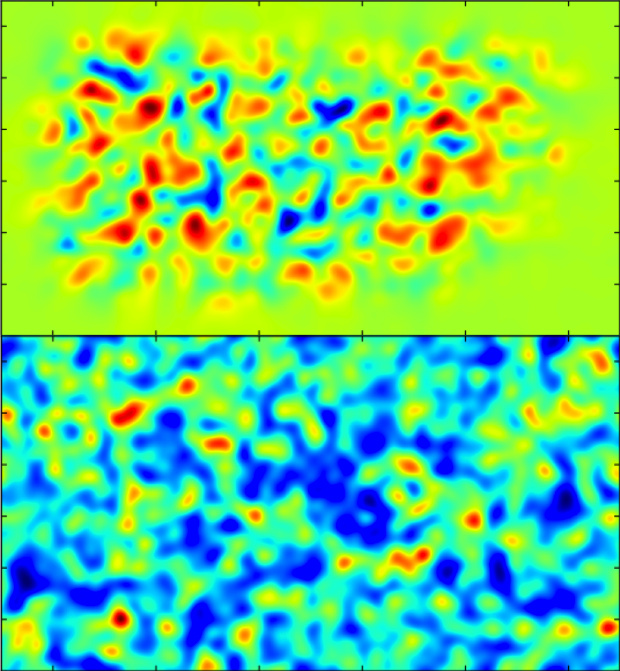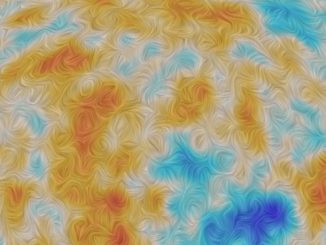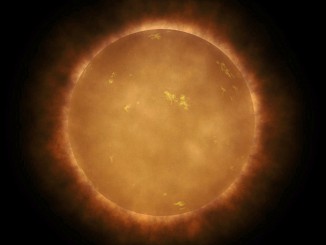
Sterile neutrino detections: dark matter candidate?
What is dark matter made of? A postgraduate student giving a talk at NAM2015 today may have an answer in the form of a mysterious spectral line in the X-ray region.
Normal, ‘everyday’ matter that makes up stars, planets, gas and dust is something that astronomers can easily detect. It either gives off, reflects, or absorbs light, electromagnetism or radiation. Dark matter’s much more shifty. It’s completely invisible, yet comprises 84.5 percent of all the mass in the Universe. Scientists only know of its existence because of the gravitational effect it has on its environment — even lensing light from distant galaxies by bending the spacetime around it.
Just as the normal matter around us is made of subatomic particles (protons, neutrons, electrons, etc), so scientists surmise, must dark matter be also. The current model favoured by many scientists for dark matter involves ‘Cold Dark Matter’ (CDM) particles, which are slow-moving compared to the speed of light. But no dark matter particle has ever been detected. However, in a talk at NAM2015, Sownak Bose from Durham University’s Institute for Computational Cosmology (ICC) presented new predictions for a different sort of candidate particle: the sterile neutrino. And it may have been detected in an X-ray spectral line.
In 2014, two independent groups detected an unexplained emission line at X-ray wavelengths in clusters of galaxies, using the Chandra and XMM-Newton X-ray telescopes. The energy of the line fits with predictions for the energies at which sterile neutrinos would decay over the lifetime of the Universe. Bose and colleagues from the ICC in Durham are using sophisticated models of galaxy formation to investigate whether sterile neutrinos corresponding to such a signal could help find the true identity of dark matter. “By modelling how the Universe has evolved from its starting point and looking at the distribution of present-day structures, such as dwarf galaxies, we can test whether sterile neutrinos or CDM best fit with observations,” says Bose. “We may have seen the first evidence for sterile neutrinos and this would be hugely exciting.”
The session chair, Professor Peter Coles says, “Although cosmology has made great progress in recent years, many questions remain unanswered. And indeed, many are unasked. This meeting is a timely opportunity to look at some of the gaps in our current understanding and some of the ideas that are being put forward for how they might be filled.”
Do cosmic jets live in dark matter ‘ponds’?
Cosmic jets — jets of material from active galaxies travelling close to the speed of light, may correlate with dense regions of dark matter in the Universe. A team of PhD students presented results at NAM2015 today that show how the Cosmic Microwave Background Radiation (CMB) can be used as an indicator to test for such a correlation.
Dark matter, however, is completely invisible. It doesn’t emit, reflect or absorb electromagnetic radiation of any kind and is only detectable by its gravitational effects (see also the previous story for today). This gravitational property is what enables dark matter to attract normal matter into ‘ponds’ that may eventually become galaxies. Indeed, many scientists think that this is how major galaxies came into existence — though this is still an intense area of research. And as of yet the nature of dark matter is completely unknown.

Along with Dr Sam Lindsay of Oxford University and Dr Blake Sherwin of UC Berkley, Allison looked for distortions in a map of the CMB using data from the Atacama Cosmology Telescope and the Very Large Array’s First Images of the Radio Sky at Twenty centimetres. Such distortions are giveaways of high mass regions, where large scale gravitation is strong. Einstein’s Theory of General Relativity predicts that strong gravity will distort spacetime, and thus the path of light, or other radiation — almost as if there was a lens in the way. The team saw just such distortions. When compared with a map showing high-than average concentrations of cosmic jets, there was a correlation.
“We can estimate the size of these dark matter halos and they’re around 10^13.6 solar masses in size,” says Allison, who is excited by the prospects of more robust data with the Square Kilometre Array; the largest radio telescope array ever-made and currently under development. As Allison says to Astronomy Now, “What we’re expecting to see is how these jets and their galaxies change over the evolutionary history of the Universe.” The existence of a correlation is just the beginning.



